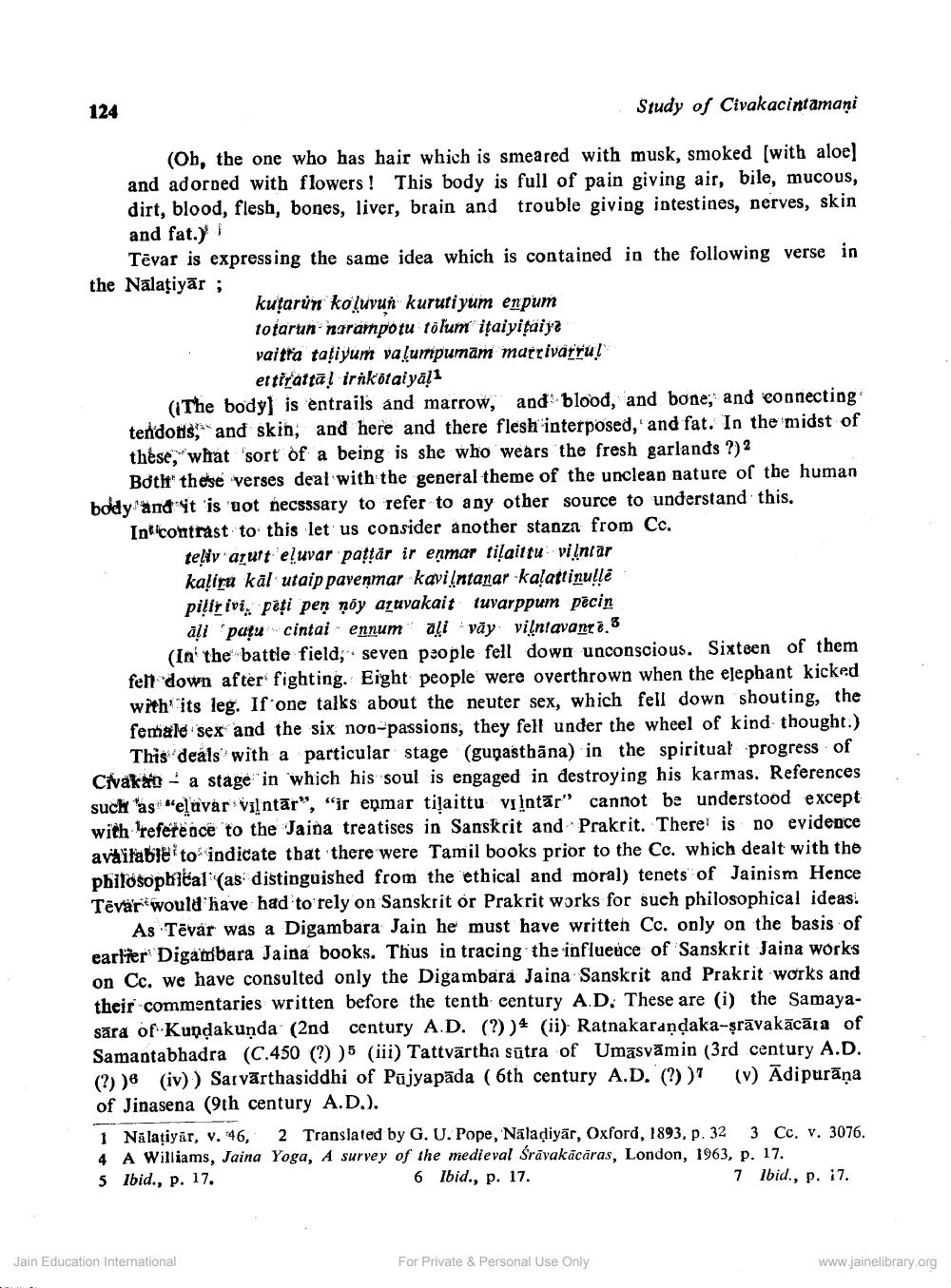________________
124
Study of Civakacintamani
(Oh, the one who has hair which is smeared with musk, smoked (with aloe) and adorned with flowers! This body is full of pain giving air, bile, mucous, dirt, blood, flesh, bones, liver, brain and trouble giving intestines, nerves, skin and fat.y!
Tēvar is expressing the same idea which is contained in the following verse in the Nalaţiyār ;
kutarůn koluvun kurutiyum enpum totarun narampotu tölum itaiyitaiya vaitta tatiyum valumpumām marrivarrul
ettirattal irnkötaiyāļi (iThe body is entrails and marrow, and blood, and bone, and connecting tendons, and skin, and here and there flesh interposed, and fat. In the midst of thèse, "' what sort of a being is she who wears the fresh garlands ?)2
Both these verses deal with the general theme of the unclean nature of the human body and 4t 'is uot necsssary to refer to any other source to understand this. In contrast to this let us consider another stanza from Cc.
teliv aruit eluvar pattår ir enmar tilaittu vilniar kaļiru kāl utaip pavemmar kaviļntanar kaļattinulle pilir ivi: pēți pen nõy asuvakaittuvarppum pēcin
āļi 'paļu cintai ennum" aļi vāy viļntavan, .3
(In the battle field, seven people fell down unconscious. Sixteen of them felt down after fighting. Eight people were overthrown when the elephant kicked with its leg. If one talks about the neuter sex, which fell down shouting, the female sex and the six noo-passions, they fell under the wheel of kind thought.)
This deals with a particular stage (gunastbāna) in the spiritual progress of Civakara stage in which his soul is engaged in destroying his karmas. References such as "elavår viļntār", "ir eņmar tiļaittu vilntār" cannot be understood except with reference to the Jaina treatises in Sanskrit and Prakrit. There is no evidence available to indicate that there were Tamil books prior to the Cc. which dealt with the philosophical (as distinguished from the ethical and moral) tenets of Jainism Hence Tēvar would have had to rely on Sanskrit or Prakrit works for such philosophical ideas.
As Tēvar was a Digambara Jain he must have written Cc. only on the basis of earlier Digambara Jaina books. Thus in tracing the influence of Sanskrit Jaina works on Cc. we have consulted only the Digambara Jaina Sanskrit and Prakrit works and their commentaries written before the tenth century A.D. These are (i) the Samayasāra of Kundakuņda (2nd century A.D. (?) )4 (ii) Ratnakarandaka-șrāvakācāia of Samantabhadra (C.450 (?) )5 (iii) Tattvārtha sūtra of Umāsvāmin (3rd century A.D. (?) )8 (iv)) Sarvārthasiddhi of Pujyapāda (6th century A.D. (?))? (v) Adipurāņa of Jinasena (9th century A.D.). 1 Nalaţiyar, v. 46, 2 Translated by G. U. Pope, Náladiyār, Oxford, 1893, p. 323 Cc. v. 3076. 4 A Williams, Jaina Yoga, A survey of the medieval Srāvakācāras, London, 1963, p. 17. 5 lbid., p. 17. 6 Ibid., p. 17.
7 lbid., p. 17.
Jain Education International
For Private & Personal Use Only
www.jainelibrary.org




